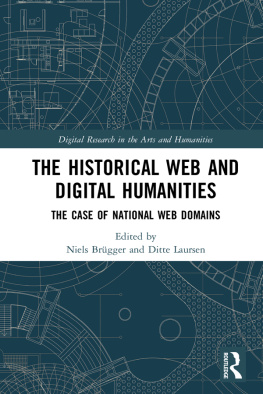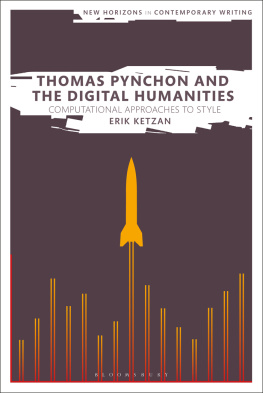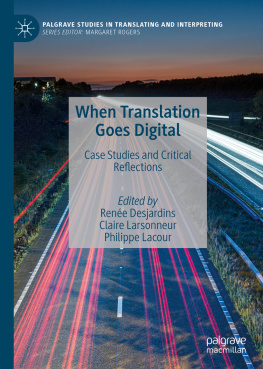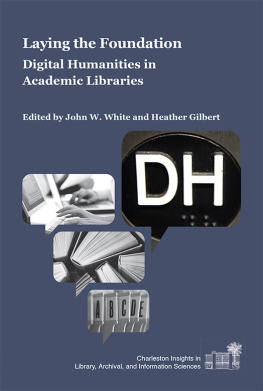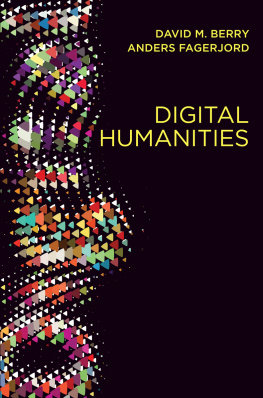Critical Digital Humanities
TOPICS IN THE DIGITAL HUMANITIES
Humanities computing is redefining basic principles about research and publication. An influx of new, vibrant, and diverse communities of practitioners recognizes that computer applications are subject to continual innovation and reappraisal. This series publishes books that demonstrate the new questions, methods, and results arising in the digital humanities.
Series Editors
Susan Schreibman
Raymond G. Siemens
Critical Digital
Humanities
The Search for a Methodology
JAMES E. DOBSON
2019 by the Board of Trustees
of the University of Illinois
All rights reserved
Publication of this book was supported by funding from
Dartmouth College.
Library of Congress Cataloging-in-Publication Data
Names: Dobson, James E., author.
Title: Critical digital humanities : the search for a methodology / James E. Dobson.
Description: [Urbana, Illinois] : University of Illinois Press, [2019] | Series: Topics in the digital humanities | Includes bibliographical references and index.
Identifiers: LCCN 2018030226| ISBN 9780252042270 (hardcover : alk. paper) | ISBN 9780252084041 (paperback : alk. paper)
Subjects: LCSH : Digital humanitiesResearchMethodology.
Classification: LCC AZ 105 . D 59 2019 | DDC 025.06/0013072dc23 LC record available at https://lccn.loc.gov/2018030226
E-book ISBN 978-0-252-05111-1
Cover images: Aerial photograph, Tokyo, March 11, 1945
(National Archives, photo no. 342-FH-3A3851-56542ac);
background image iStock.com/A. Zabnina.
Contents
Preface
Hail, Screen, on which screen-theory may be thrown
While we sit back reflecting! As it grows,
Reflect indeed; for is this our reflection?
What lends it what authority? Who knows
If not this casement opening onIts Own?
I. A. Richards, The Screens
[T]he science of literature is an always infinite discourse,
an always open enunciation of a search for the laws of the practice
known as literature. The objective of this search is
to make manifest the very procedure through which this science,
its object and the relationship are brought about, rather than to
apply empirically such and such a technique
to an indifferent object.
Julia Kristeva, Desire in Language: A Semiotic Approach to Literature and Art (italics in original)
What follows is a critique of existing and potential computational methods for the analysis and interpretation of text and data within the humanities. Quantitative formalism, distant reading, algorithmic criticism, macroanalysis, computer-aided text mining: whatever we call and however we conceptualize At the same time, it assumes that these approaches cannot and will not make obsolete other existing interpretive frameworks. The discourse of the humanities, as Julia Kristeva reminds us, is an infinite discourse. Neither the methods nor the objects within such a framing are capable of settling into inertia or abruptly coming to a breaking halt. It is the infinite search for a method that prevents the humanities from staying fixed long enough for anyone to say that the objects or the methods have finally given it their all and spoken all there is to say. Take, for example, the multitude of ways in which the most canonical collection of texts, Shakespeares plays or the works of Homer, have been reimagined and rethought by every generation using the approaches and tools of almost every school of criticism and theory.
There are those who argue that a wholesale reinvention underpinned by the algorithmic manipulation of texts and other objects is the only way to recover an assumed loss of disciplinary prestige and an interest in the humanities from our students. Drawing on what appears to be a successful model in the sciences, advocates of a big data experimental and lab-based quantitative humanities take the obsolete nature of critical inquiry as a given.culture in which these objects reside. This founding assumption has served some scholars well, especially those working within the interdisciplinary field of cultural studies, but it has also been subject to numerous critiques for broad generalizations, overreaching, and inadequate understandings of the lived experience of people within a culture.
The objects of culture that seem at present to be of the most interest to humanists making use of these computational methods are creative and imaginative textsfiction, and especially the nineteenth-century English language novel with its more standardized formatting and spelling, remains the dominant object of analysis. While these objects might refer to extra-textual events and people and certainly make use of a range of language that can index cultural formations and dominant ideologies, novels are incredibly unreliable sources of information about culture. Narrative fiction, for example, could be understood as a rhetorical strategy that negotiates the difference between showing or telling and in the process [calling] attention to the authors selecting presence or perhaps it might be understood as providing an imaginary resolution of a real contradiction. Nor can the computational literary critic assume that the collection of fiction produced and reproduced by university libraries can adequately represent culturenow or at any time in the past.
This book takes seriously the arguments that quantitative and computational methods have already enabled humanists to produce new insights and that these methods will increasingly lead humanists to develop fascinating new arguments. But at the same time, it reminds scholars that possibilities for reading and interpretation exist other than the documentary realist treatment of digital or digitized sources. The extraction of information about culture from texts, in short, does not fully capture the methodological variety of humanistic practices, nor does this type of evidence or even the category of information trump other categories of evidence or strategies of reading, digital or otherwise.
The following four chapters seek to outline core problems with many of the assumptions found in the basic building blocks of any text-based computational analysis used in the humanities. The examples of text mining and other computational methods invoked will tend toward describing these procedures as abstractions of classes of activitypotential and projective forms of Classes of activity examined in the following pages include segmentation, normalization, classification, clustering, and modeling. The computational methods used in the humanities are undergoing rapid changemany of these methods are still in their infancyand this book offers a critical account of these developing procedures and methods. These procedures and methods extend the horizon of interpretive possibilities, in the Husserlian sense, but this horizon is not unlimited, despite the potentially vast quantities of an objects qualities that are brought into aspect. This book examines the conditions of what might be called the seen and unseen of the interpretive scene in computational criticism.
Yet, as we proceed down through the stack of computational methodology from datasets to algorithms, as we slowly work our way through the multiple vectors and layers of critique, we will need some example data that are freely accessible, understandable, and ready for analysis. I borrow the term stack from systems engineering to describe the interlinked and dependent layers of tools and abstractions that make up any contemporary computational application or procedure. The presence of these obscured layers plays an important role in the major claim of this book, that computational criticism is a situated rather than an empirical and objective activity. This critical situation, as it were, can be better made visible through the friction generated by the application of method to data. Almost all of the data or texts used as examples in the following chapters are found within the North American Slave Narrative archive of the University of North Carolinas Documenting the American South digital library. This archive, assembled over a decade and edited by William L. Andrews, was initially created to expand the restrictive and reductive canonan important goal shared by this books centering of slave narratives. It is an exemplary archive for digital humanities research, exemplary not because of its archival completeness or its thorough description and structured organizational schema, but precisely the oppositethis digital archive demonstrates, through its disorganization, its partial and almost haphazard construction, important truths of all archival projects.


